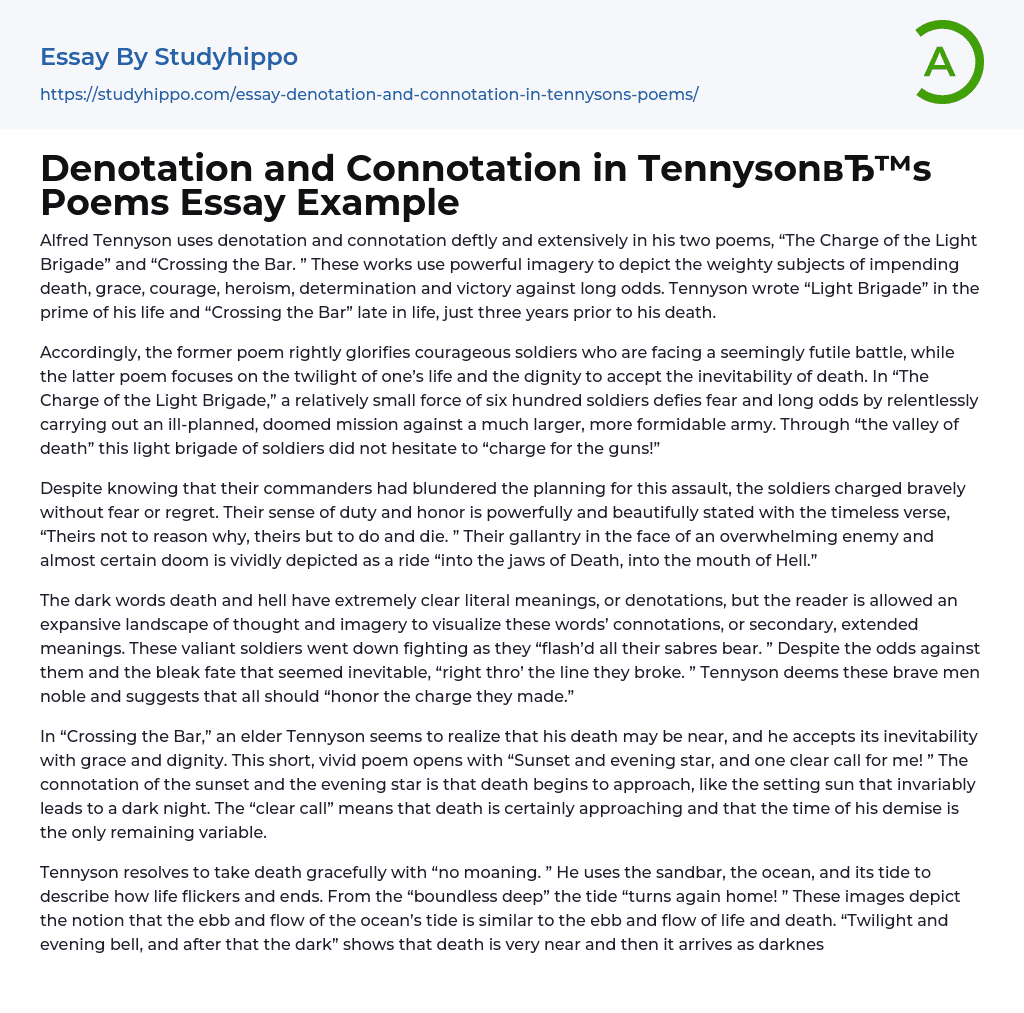

Denotation and Connotation in Tennyson’s Poems Essay Example
Alfred Tennyson uses denotation and connotation deftly and extensively in his two poems, “The Charge of the Light Brigade” and “Crossing the Bar. ” These works use powerful imagery to depict the weighty subjects of impending death, grace, courage, heroism, determination and victory against long odds. Tennyson wrote “Light Brigade” in the prime of his life and “Crossing the Bar” late in life, just three years prior to his death.
Accordingly, the former poem rightly glorifies courageous soldiers who are facing a seemingly futile battle, while the latter poem focuses on the twilight of one’s life and the dignity to accept the inevitability of death. In “The Charge of the Light Brigade,” a relatively small force of six hundred soldiers defies fear and long odds by relentlessly carrying out an ill-planned, doomed mission ag
...ainst a much larger, more formidable army. Through “the valley of death” this light brigade of soldiers did not hesitate to “charge for the guns!”
Despite knowing that their commanders had blundered the planning for this assault, the soldiers charged bravely without fear or regret. Their sense of duty and honor is powerfully and beautifully stated with the timeless verse, “Theirs not to reason why, theirs but to do and die. ” Their gallantry in the face of an overwhelming enemy and almost certain doom is vividly depicted as a ride “into the jaws of Death, into the mouth of Hell.”
The dark words death and hell have extremely clear literal meanings, or denotations, but the reader is allowed an expansive landscape of thought and imagery to visualize these words’ connotations, or secondary, extended meanings. These valian
soldiers went down fighting as they “flash’d all their sabres bear. ” Despite the odds against them and the bleak fate that seemed inevitable, “right thro’ the line they broke. ” Tennyson deems these brave men noble and suggests that all should “honor the charge they made.”
In “Crossing the Bar,” an elder Tennyson seems to realize that his death may be near, and he accepts its inevitability with grace and dignity. This short, vivid poem opens with “Sunset and evening star, and one clear call for me! ” The connotation of the sunset and the evening star is that death begins to approach, like the setting sun that invariably leads to a dark night. The “clear call” means that death is certainly approaching and that the time of his demise is the only remaining variable.
Tennyson resolves to take death gracefully with “no moaning. ” He uses the sandbar, the ocean, and its tide to describe how life flickers and ends. From the “boundless deep” the tide “turns again home! ” These images depict the notion that the ebb and flow of the ocean’s tide is similar to the ebb and flow of life and death. “Twilight and evening bell, and after that the dark” shows that death is very near and then it arrives as darkness envelops life. Tennyson’s destination following death is unknown as “the flood may bear me far.”
Finally after crossing the bar, which is the threshold or barrier that separates life and death, he wonders about God and the afterlife. His wish for heaven and the afterlife is embodied in the “Pilot” who he hopes to
meet “face to face when I have crost the bar. ” Both poems address life and death and depict many positive attributes that human beings possess. Bravery and determination are applauded in life, and dignity and hope are trumpeted as death approaches.
- John Locke essays
- 9/11 essays
- A Good Teacher essays
- A Healthy Diet essays
- A Modest Proposal essays
- A&P essays
- Academic Achievement essays
- Achievement essays
- Achieving goals essays
- Admission essays
- Advantages And Disadvantages Of Internet essays
- Alcoholic drinks essays
- Ammonia essays
- Analytical essays
- Ancient Olympic Games essays
- APA essays
- Arabian Peninsula essays
- Argument essays
- Argumentative essays
- Art essays
- Atlantic Ocean essays
- Auto-ethnography essays
- Autobiography essays
- Ballad essays
- Batman essays
- Binge Eating essays
- Black Power Movement essays
- Blogger essays
- Body Mass Index essays
- Book I Want a Wife essays
- Boycott essays
- Breastfeeding essays
- Bulimia Nervosa essays
- Business essays
- Business Process essays
- Canterbury essays
- Carbonate essays
- Catalina de Erauso essays
- Cause and Effect essays
- Cesar Chavez essays
- Character Analysis essays
- Chemical Compound essays
- Chemical Element essays
- Chemical Substance essays
- Cherokee essays
- Cherry essays
- Childhood Obesity essays
- Chlorine essays
- Classification essays
- Cognitive Science essays



